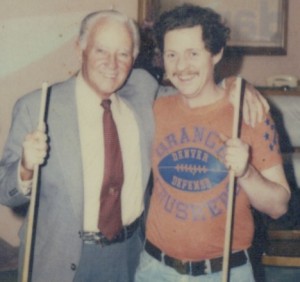December 15, 1941 – February 6, 2013
San Francisco, California Randall “Randy” Givens passed away Feb. 6, 2013 at age 73, following years of poor health. A colorful character in the San Francisco medical marijuana activist scene, he was a pool hustler, a supporter of Prop 215 – California’s 1996 medical use initiative, and a common fixture at the SF Cannabis Buyers’ Club SF-CBC until it was shut down by the state in 1998, long before SB 420 authorized patient collectives.
He was one of five children born and raised in Springfield. He moved to San Mateo, CA in the 1960s but returned to San Francisco in the early 1970s and worked as a custom cabinet maker and woodworker into the 1980s. He sold marquetry artwork as a San Francisco street artist during that time. He was a columnist for several years with “Pool and Billiard” magazine, a national publication, and he also wrote the book Eight Ball Bible, a comprehensive and definitive book on Tavern Bar Table Eight Ball (seven-foot table).
A regular contributor to the DPFCA drug policy discussion group through its statewide email listserve, Givens engaged other reform activists in energetic discussions of provocative political and legal strategies, such as the one below on how to treat the topics of “marijuana DUI” and “drugged driving.” Likewise he was a talented and successful writer of pointed letters to the editor, most frequently the San Francisco Chronicle. He gave a passionate presentation at the 2011 California NORML Next Steps conference in Berkeley.
Givens was opinionated, thought provoking, enthusiastic, optimistic and a fighter to the end. He wrote several hundred articles and letters that were printed in newspapers across the country going back to the early 80s, advocating for the complete legalization of marijuana. In personal conversations with in the months before his death, Givens insisted that the only way to unite the movement is by focusing on its common enemy of prohibition and demanding that marijuana reformers should give no quarter to their political foes but needs to hammer the opposition with a one-two punch of strong facts and strong rhetoric. He believed that if he could just get into the room with George Soros for one hour, it would open the floodgates of his wealth to make marijuana legal for adults, but he never got the chance. Others have to carry on his spirit from here.
He leaves his daughter Cara Givens and her mother his Life partner and friend Janice Antrillo from San Francisco. He is also survived by his mother Francis Transnik in Springfield, Ill.
— George Michaels, with Chris Conrad
Below is a posting by Randy Givens dated October 17, 2012:
Drug testing drivers for marijuana hurts public safety
Legislators should have done some basic research before assuming that
marijuana use automatically disables a driver. Assuming that
marijuana presents a danger on the highway is a mistake because the
facts prove that marijuana smokers are the safest drivers. US
Department of Transportation surveys universally show that marijuana
drivers have the lowest fatal accident rate of any category. All
available evidence indicates that cannabis using drivers are safer
than teetotalers.
D. Mark Anderson’s recent study showing a 9 percent decrease in
traffic fatalities in states with medical marijuana laws further
demonstrates that marijuana has a beneficial effect on stoned
drivers. Instead of increasing the death toll on the roadways,
marijuana lowers the accident rate. This decline was linked directly
to a drop in the practice of drunk driving. Persons living in states
that had legalized medical marijuana were less likely to drive under
the influence of alcohol, and more likely to use marijuana instead.
The idea of punishing pot smokers who drive safely is
counterproductive.
“Are California’s Medical Marijuana Laws Responsible for Fewer Fatal Traffic Accidents?”
The Drugs and Accident Risk in Fatally-Injured Drivers survey
concluded that marijuana has a “negative risk factor” for fatal
highway accidents. A “negative risk factor” means that pot smokers
have a lower accident rate than teetotalers. It is a scientifically
verified fact that marijuana users are safer drivers than sober
drivers.
“Drivers in whom only opiates were detected had an odd’s ratio of
2.4, whilst marijuana cases provided a relative risk of 0.6. Drivers
in whom stimulants were detected gave an odd’s ratio of 1.4 whilst
benzodiazepines gave an odd’s ratio of 1.0. By contrast the odd’s
ratio for alcohol was 6.8.”
“It was of some interest that cannabis tended to show a negative
effect on relative risk when other drug groups showed an increase.
This phenomenon has also been seen elsewhere [Terhune et al, 1992;
Williams et al, 1985]. The most likely reason probably relates to the
over compensation of marijuana-using drivers on their driving skills.
Over compensation may be caused simply by slowing down and avoiding
adverse driving situations. These observations do not seem to be
related to whether delta-9-THC or 11-carboxy-THC are measured in
blood [Terhune et al, 1992; Williams et al, 1985].”
See: NIH Report, NORML, Drug War Chronicle, DUI report, article, druglibrary.org
This is not theory or guesswork. The numbers are based on actual
highway fatalities, actual drug tests and a determination of who was
at fault. After accident fault was assigned to each driver it was
found that marijuana users had the lowest accident responsibility
rate of any category.
Drug crusaders who claim that marijuana poses a danger on the
highway need to tell us exactly how many deadly collisions are caused
by stoned drivers. According to all previous research most stoned
drivers are not responsible for the accidents that kill them. They
are killed by drunks and distracted drivers.
Rather than zeroing in on stoned drivers who have proved to be the
safest category, people should focus on impaired drivers which can be
found using the standard roadside impairment test. If a driver is
impaired he/she should not be driving. However, merely being stoned
does not indicate impairment.
Putting a bad policy into effect is not progress.
– Randy Givens


